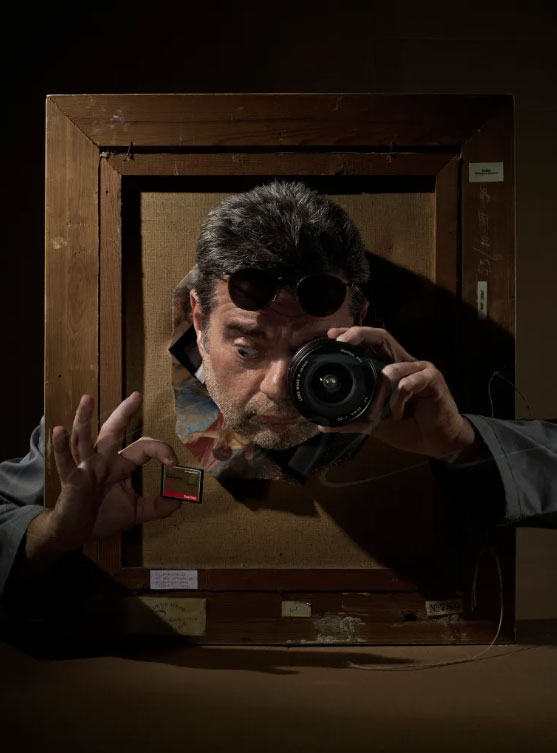Bart Ramakers is a Belgian art photographer, best known for his photographs reimagining ancient mythological themes in a modern context. In 1987, Ramakers also drew a comic strip, 'Layla', scripted by Pascal Lefèvre and printed in the movie magazine Film Take One.
Early life and career
Bart Ramakers was born in 1963 in Maaseik, in the Belgian province Limburg. As a child, he already enjoyed drawing and painting, inspired by the 15th and 16th-century Flemish Primitives. Since Maaseik is the birth town of the medieval painters Jan and Hubert van Eyck, Ramakers was exposed to their work from an early age. Over the years, he absorbed influences from several other artists, among them Félicien Rops. Ramakers studied art at the Academies of Maaseik and Maasmechelen, followed by a history course at the Catholic University of Leuven. During his college days he worked as cartoonist, illustrator and graphic artist for student magazines like Veto. After graduation, Ramakers spent several decades working in the marketing and communication sector.
Layla
Between 4 March and 16 November 1987, Ramakers drew a comic strip titled 'Layla', using the pseudonym Barst. Scripted by Pascal Lefèvre (under the pseudonym Paliski), the comic ran in Film Take One, a magazine issued by the video store company SuperClub to promote their latest video releases. The plot of 'Layla' revolved around a man who sabotages film sets in Hollywood. Lefèvre and Ramakers knew each other from their college years. When 'Layla' was serialized, Ramakers was fulfilling his military service, so he drew the comic in his spare time.
Pascal Lefèvre moved on to become a well-respected comic theoretician, researcher and historian. For Ramakers it would be his first and only work in the comic industry. SuperClub later turned out to be an unsound business, which through investments of Philips managed to survive until 1997, before collapsing in bankruptcy and business fraud.
Poster for the project 'Autopia'.
Photography
Ramakers' career as an art photographer took off in 2009. With help from his partner Sofie Baert, he stages photographs based on stories from Greek-Roman mythology, the Bible and other myths and legends. The images often have double layers and make visual nods to classic paintings and engravings. Several scenes also offer satirical commentary on modern-day issues, such as racism, gender politics and climate change. His intention is to craft a "mythology for a new world". At times, Ramakers has collaborated with other artists, such as Tom Herck, Panamarenko and William Sweetlove. With Ben Stimulé, he made 'Autopia - Automats for a New World' (2018), a collection of crafty machines that can tackle all the great challenges of modern society. Ramakers' photograph 'Around the World in 80 Years' (2019) depicts the 79-year old conceptual artist Panamarenko as Phineas Fogg from the Jules Verne novel 'Around the World in 80 Days', placing the bet that he will travel the globe in 80 days. In the picture, Panamarenko is surrounded by Flemish media celebrities playing characters from the story, namely TV hosts Mark Uytterhoeven and Rob Vanoudenhoven, Humo chief editor Guy Mortier, fellow artist Bart Persoons, Noordkaap lead singer Stijn Meuris and Panamarenko's wife Eveline. It happened to be the last project Panamarenko worked on; he died two days after the photo sessions. With William Sweetlove, Ramakers created 'Flora and the Water Warriors' (2019), using water nymphs to make a statement about environmental problems. Apart from photography, Ramakers has also created sculptures and video installations. He also shot the photograph on the cover of Guido Belcanto's music album 'In De Kronkels Van Mijn Geest' (2021).
Ramakers' photo book 'The Bride Unveiled' (2020) is notable for telling the story of a cardinal and his twin brother in a series of staged photographs. The twin brother is a former journalist, dressed in a blue sweater, golf trousers, white socks and black shoes. He is called Linlin and has a quiff on his head, making him an obvious nod to Hergé's comic character Tintin. The same year, Ramakers also shot a photograph titled 'Muse Checkmate', based on an art photograph where Belgian conceptual artist Marcel Broodthaers plays chess with a nude woman. In Ramakers' partial recreation, the cartoonist Herr Seele took the place of Broodthaers playing chess with a nude model. The photo sessions were organized in the restaurant Hotel du Parc in Ostend, where in 1981 Herr Seele and Kamagurka had invented their long-running comic series 'Cowboy Henk'.
Ramakers' photographs have been frequently exhibited in galleries all over Flanders. Some are part of permanent collections. For people interested in Ramakers' photographic work, the books 'Revelations: The Book' (2018) and 'The Bride Unveiled' (2021) are highly recommended.
Self-portrait from Ramakers' 2020 series 'Auto-portraits'.





